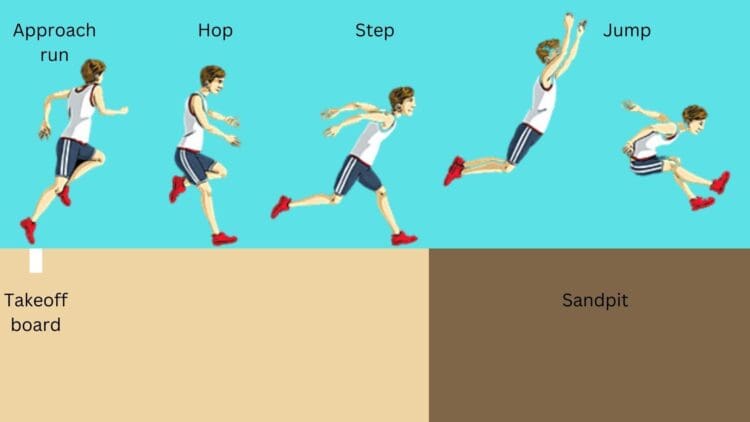
OBJECTIVE OF TRIPLE JUMP: Jump the farthest distance possible.
NUMBER OF PLAYERS: 1+ player(s)
MATERIALS: Athletic wear
TYPE OF GAME: Sport
AUDIENCE: 9+
OVERVIEW OF TRIPLE JUMP

Triple jump is an Olympic track and field event that revolves around jumping the farthest distance possible. Unlike long jump, which is a similar event in which the objective is solely to jump as far as possible, triple jump requires an athlete to use a specific hop-bound-jump combo—a sequence of three total jumps, hence the name.
It is thought that triple jump originated as a misinterpretation of an Ancient Olympic event. Historians found evidence that Ancient Olympians were recording jumps of 15 meters (49 feet) or more, a feat that would only be possible if multiple jumps were performed. However, it is possible that this event never existed in ancient times and was instead just an exaggeration of long jump results from biased authors.
Regardless of historical inaccuracy, a standing triple jump event was held at the inaugural 1896 Olympic Games and every other Summer Olympics since.
In 1908 a new format coined the Hop, Skip, and Jump, was implemented. James Connally was the first modern Olympic champion to win under the new ruling. In the 1996 the Women’s triple jump event made its debut.
SETUP
The only equipment required to participate in triple jump is comfortable and non-restrictive clothing, such as that worn by all other track and field athletes.
However, this event does require the use of a runway and a sandpit (the same one used for long jump).
GAMEPLAY

THE THREE-JUMP SEQUENCE
Just like in long jump, a triple jump attempt begins with a running start. Upon reaching the takeoff board, the athlete must “hop” off one foot, land on that same foot, and then “bound” forward off that same foot , using the drive leg thigh, again before landing with their opposite leg on their opposite foot and taking a final standing long jump into the sand pit with that one leg.
Due to the numerous one-legged hops, it is extremely difficult for an athlete to generate high amounts of force on their final jump. Regardless, the three total hops still give them enough momentum to cover distances of up to 60 feet!
Check out exactly how the three-jump sequence works here:
Rio Replay: Men’s Triple Jump Final
THE RUNWAY AND TAKEOFF
The runway is the solid ground on which the entire jump phase (apart from the final landing) takes place. This runway is usually made of the same red-colored rubber material covering the main track.
Along the runway is a takeoff board. This movable board is used in both triple jump and long jump to signify where the athlete must start their jump from. At the end of the board, there is a distinct foul line; if any part of an athlete’s foot goes over this line, the attempt is discarded.
The takeoff board is important in triple jump because it can be moved based on the athlete’s ability. Since top triple jump athletes regularly cover more than 55 feet with their three-jump sequence, some competitors place this board as far back as 40 feet from the sand pit. Of course, this does not affect the measurement of the athlete’s jump, but adjusting it gives athletes enough room to complete their entire jump sequence on the runway while also ensuring they actually land in the sand pit. Keep in mind that in competition, the takeoff board is fixed in place according to the athlete’s declared preferences before the start of the event. And the athlete must start their three jumps from the same distance for all their attempts.
SCORING
Placements in the triple jump event are based on the distance from the takeoff line that an athlete reaches with their final jump. The distance of the jump is measured to the back-most part of the athlete’s body that touches the sand. Therefore, an athlete should be aware of this and avoid falling backward, which could subtract distance away from their jump.
Depending on the competition, each athlete has between three and six jump attempts. Only the farthest attempt is used to determine placements.
END OF GAME
The athlete who covers the most distance with their three-jump sequence wins the triple jump event.
- 30 GAMES TO PLAY OVER TEXT - April 22, 2024
- 20+ FREE PRINTABLE BABY SHOWER GAMES - April 16, 2024
- 20+ College Party Games for the Best Night Ever! - April 2, 2024